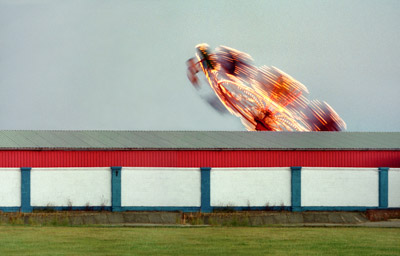28.06.2002 - 12.01.2003
Marina Abramovic, Francis Alÿs, Matthew Barney, Uta Barth, Oliver Boberg, Jeff Burton, James Casebere, Patty Chang, Miles Coolidge, Gregory Crewdson, Thomas Demand, Rineke Dijkstra, Trisha Donnelly, Stan Douglas, Olafur Eliasson, Elger Esser, Fischli & Weiss, Thomas Flechtner, Anna Gaskell, Nan Goldin, Douglas Gordon, Katy Grannan, Andreas Gursky, Ann Hamilton, Anthony Hernandez, Pierre Huyghe, William Kentridge, Glenn Ligon, Iñigo Manglano-Ovalle, Annette Messager, Mariko Mori, Shirin Neshat, Rika Noguchi, Catherine Opie, Gabriel Orozco, John Pilson, Pipilotti Rist, Michal Rovner, Thomas Ruff, Anri Sala, Jörg Sasse, Simon Starling, Thomas Struth, Sam Taylor-Johnson, Diana Thater, Wolfgang Tillmans, Kara Walker, Jane & Louise Wilson,
During the late 1960s and 1970s, a paradigm shift occurred within visual culture: photography and the moving image were absorbed into critical art practices. In particular, these mediums were used to record ephemeral or performative events and to render visible conceptual systems or to question the supposed objectivity of representation itself. Moving Pictures focuses primarily on artworks from the last decade and proposes that the extensive use of reproducible mediums in today’s art has its roots in an earlier formative period.
The presence of photography, film, and video in the most radical art practices of the 1970s corresponded to their ubiquity in all forms of popular representation: television, advertising, cinema, and print journalism. Artists turned to these mediums—which bridged such discrete categories as mass culture and high art, technology and culture—in order to contest the preciousness of the unique art object and to challenge traditional aesthetic categories. Additionally, this new, portable technology of video and its unique ability to employ instant playback allowed artists to examine issues of representation and image making to an unprecedented degree. For many early feminist artists, these mediums represented yet-to-be-claimed territory, offering a new means with which to render experiential work.
By the end of the 1970s, many artists turned to photography as a vehicle through which to critique photographic representation and to subvert an art system premised on the notion of the original. While this practice came to define much of the 1980s postmodern art, its legacy for the 1990s was essentially the license to indulge in photographic fantasy, image construction, and cinematic narrative. Artists working today freely manipulate their representations of the empirical world or invent entirely new cosmologies. They process their subject matter through conceptual systems or use digital processes to alter their images. Some directly intervene in the environment, subtly shifting components of the found world and establishing their quiet presence in it; others fabricate entire architectural environments for the camera lens.
Drawn from the Guggenheim Museum’s permanent collection, this exhibition proceeds chronologically after a prologue on the first level examines unexpected ways in which contemporary artists have utilized reproducible mediums. Artists from the 1970s, whose performative, time-based work has been deeply influential on artists working today, are featured on the second level. The installation then focuses exclusively on work created during the last twelve years that utilizes photography and video. Though aesthetically and conceptually diverse, the works share a certain distanced relationship to reality—privileging invention or intervention over documentation.
Throughout the 1970s, artists such as Marina Abramovic, Vito Acconci, Bruce Nauman, and Robert Smithson employed photographic strategies to extend and test traditional, medium-specific boundaries such as painting, sculpture, and fine-art photography. Additionally, the new, relatively inexpensive and portable technology of video and its unique ability to provide instant playback, live and closed-circuit installations as well as multichannel configurations allowed artists such as Nam June Paik to examine issues of representation and image making to an unprecedented degree. Film as installation further expanded the conceptual and aesthetic parameters of the moving image.
The presence of photography, film, and video in the most radical art practices of this period corresponded to the ubiquity of these mediums in all forms of popular representation: television, advertising, cinema, and print journalism. Artists turned to these mediums—which bridged such discrete categories as mass culture and high art, technology and culture—in order to contest the autonomous art object and transgress the traditional categories of modernism. Photography, film, and video functioned as means for achieving these goals, enabling artists to create works that privileged information or documentary evidence over personal expression, or conversely called into question notions of objective recorded reality, underscoring the dominance of mass media and its often skewed representations. For many early feminist artists such as Ana Mendieta and Hannah Wilke, these mediums represented yet-to-be-claimed territory, offering them new means with which to render their own subjective experiences.
By the end of the 1970s, artists such as Cindy Sherman turned to photography as a vehicle through which to critique photographic representation itself. While this practice came to define much 1980s postmodern art, its legacy for the 1990s was essentially the license to indulge in photographic fantasy, image construction, and cinematic narrative. Many artists, including Olafur Eliasson, Elger Esser, Andreas Gursky, Jörg Sasse, and Hiroshi Sugimoto, freely manipulate the empirical world and their representations of it, processing their subject matter through preordained conceptual systems or using digital processes to alter their images. Others, like Matthew Barney, Gregory Crewdson, Anna Gaskell, and Sam Taylor-Wood, stage fictional narratives, inventing entirely new cosmologies for the camera. Still others, like Gabriel Orozco, intervene directly in the environment, subtly shifting components of the found world and establishing a quiet presence in it, while some artists construct entire architectural environments for the camera lens.
If the art of the 1970s was marked by temporal, performative practices and that of the 1980s was distinguished by its relationship to critical theory, art of the 1990s witnessed a reversal of methodologies with the widespread resuscitation of time-based, process-oriented artistic practices and their attendant use of photography and the moving image. Such work is often ephemeral in nature.The use of video and film—time-based mediums par excellence—has proliferated in the last twelve years, as evidenced in the work of Barney, Stan Douglas, William Kentridge, Iñigo Manglano-Ovalle, Steve McQueen, Shirin Neshat, John Pilson, Pipilotti Rist, and Gillian Wearing.
|



